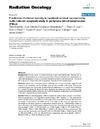Identificador persistente para citar o vincular este elemento:
https://accedacris.ulpgc.es/jspui/handle/10553/9022
| Título: | Prediction of clinical toxicity in localized cervical carcinoma by radio-induced apoptosis study in peripheral blood lymphocytes (PBLs) | Autores/as: | Bordón, Elisa Henríquez Hernández, Luis Alberto Lara Jiménez, Pedro Carlos Pinar, Beatriz Fontes Neto, Fausto Góes Rodríguez-Gallego, Carlos Lloret Saez-Bravo, Marta |
Clasificación UNESCO: | 320101 Oncología | Palabras clave: | Breast-Cancer Patients Radiation-Induced Apoptosis Radiotherapy Radiosensitivity Individuals, et al. |
Fecha de publicación: | 2009 | Publicación seriada: | Radiation Oncology | Resumen: | Background: Cervical cancer is treated mainly by surgery and radiotherapy. Toxicity due to radiation is a limiting factor for treatment success. Determination of lymphocyte radiosensitivity by radio-induced apoptosis arises as a possible method for predictive test development. The aim of this study was to analyze radio-induced apoptosis of peripheral blood lymphocytes. Methods: Ninety four consecutive patients suffering from cervical carcinoma, diagnosed and treated in our institution, and four healthy controls were included in the study. Toxicity was evaluated using the Lent-Soma scale. Peripheral blood lymphocytes were isolated and irradiated at 0, 1, 2 and 8 Gy during 24, 48 and 72 hours. Apoptosis was measured by flow cytometry using annexin V/propidium iodide to determine early and late apoptosis. Lymphocytes were marked with CD45 APC-conjugated monoclonal antibody. Results: Radiation-induced apoptosis (RIA) increased with radiation dose and time of incubation. Data strongly fitted to a semi logarithmic model as follows: RIA = βln(Gy) + α. This mathematical model was defined by two constants: α, is the origin of the curve in the Y axis and determines the percentage of spontaneous cell death and β, is the slope of the curve and determines the percentage of cell death induced at a determined radiation dose (β = ΔRIA/Δln(Gy)). Higher β values (increased rate of RIA at given radiation doses) were observed in patients with low sexual toxicity (Exp(B) = 0.83, C.I. 95% (0.73-0.95), p = 0.007; Exp(B) = 0.88, C.I. 95% (0.82-0.94), p = 0.001; Exp(B) = 0.93, C.I. 95% (0.88-0.99), p = 0.026 for 24, 48 and 72 hours respectively). This relation was also found with rectal (Exp(B) = 0.89, C.I. 95% (0.81-0.98), p = 0.026; Exp(B) = 0.95, C.I. 95% (0.91-0.98), p = 0.013 for 48 and 72 hours respectively) and urinary (Exp(B) = 0.83, C.I. 95% (0.71-0.97), p = 0.021 for 24 hours) toxicity. Conclusion: Radiation induced apoptosis at different time points and radiation doses fitted to a semi logarithmic model defined by a mathematical equation that gives an individual value of radiosensitivity and could predict late toxicity due to radiotherapy. Other prospective studies with higher number of patients are needed to validate these results. | URI: | https://accedacris.ulpgc.es/handle/10553/9022 | Otros identificadores: | http://dx.doi.org/10.1186/1748-717X-4-58 | DOI: | 10.1186/1748-717X-4-58 | Fuente: | Radiation Oncology 2009, 4:58 |
| Colección: | Artículos |
Citas SCOPUSTM
46
actualizado el 08-jun-2025
Citas de WEB OF SCIENCETM
Citations
41
actualizado el 08-jun-2025
Visitas
74
actualizado el 23-ene-2024
Descargas
110
actualizado el 23-ene-2024
Google ScholarTM
Verifica
Altmetric
Comparte
Exporta metadatos
Los elementos en ULPGC accedaCRIS están protegidos por derechos de autor con todos los derechos reservados, a menos que se indique lo contrario.
